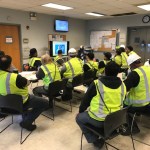
The Importance of Electrical Safety Training: Protecting Your Workers and Your Business
February 6, 2023
Electrical Accidents in the Workplace: How Proper Training Can Save Lives
February 9, 2023 Electrical dangers in the workplace:
Electrical dangers in the workplace:
why the NFPA 70E standard is just the first step
Electricity is an important part of modern life. Homes, businesses, and industries all need it to run. Electricity has a lot of good uses, but if it isn’t used correctly, it can also cause a lot of damage. Electrical hazards in the workplace can cause serious injuries or even death if workers aren’t taught how to spot and avoid them. The National Fire Protection Association (NFPA) has made the NFPA 70E standard, which gives guidelines for electrical safety in the workplace, to reduce the risk of electrical hazards. But even though this standard is an important step toward improving electrical safety, it is only the first step in protecting workers from electrical hazards.
In the workplace, electrical hazards can come in many forms, such as shock, arc flash, and electrical burns. Shock happens when electrical current flows through a person’s body, which can cause muscle contractions, cardiac arrest, and death. Arc flash is a sudden release of electricity that can cause serious burns, hearing loss, and other injuries. Direct contact with electrical conductors can cause electrical burns, which can do a lot of damage to the skin and the tissues underneath it.
The NFPA 70E standard gives guidelines for electrical safety in the workplace to reduce the risk of electrical hazards. These guidelines include requirements for safe work practices, personal protective equipment (PPE), and training in electrical safety. These rules are meant to help employers and workers understand the risks that come with electrical hazards and to give them steps they can take to lower these risks.
The NFPA 70E standard says that employers have to do hazard assessments to find electrical hazards in the workplace and put in place safe ways to work around these hazards. This includes taking steps like turning off the power to electrical equipment before maintenance, using lock-and-tag procedures to control the release of electrical energy, and making sure workers have the right PPE, like arc flash protective clothing, to keep them safe from electrical hazards.
In addition to hazard assessments and safe work practices for electrical safety, the NFPA 70E standard also says that workers who do jobs that expose them to electrical hazards must get training in electrical safety. This training should cover the types of electrical hazards in the workplace, how to keep electrical energy under control, and how to use PPE. Workers should also be taught how to choose, use, and take care of PPE for electrical work, as well as how to spot and avoid electrical hazards.
Even though the NFPA 70E standard is a big step toward making electrical work safer, it is important to remember that it is only the first step. The standard gives guidelines for electrical safety, but it does not cover all electrical hazards in the workplace. Employers and employees both need to do their part to keep the workplace safe by following the rules set out in the standard and keeping an eye out for new electrical hazards and making changes to safety procedures as needed.
Aside from following the rules set out in the NFPA 70E standard, employers and workers can also take other steps to make the workplace safer when it comes to electricity. For example, employers can set up an electrical safety program that includes regular training, hazard assessments, and regular audits to make sure that all electrical safety procedures are being followed. Workers can also do their part to improve electrical safety by reporting electrical hazards at work, getting training in electrical safety, and following all safety rules.
In the end, electrical hazards in the workplace pose a very real risk to workers. The NFPA 70E standard gives important rules for reducing these risks, but it is only the first step in making sure that electrical systems are safe. Employers and employees both need to do their part to keep electrical work safe by following the rules.




